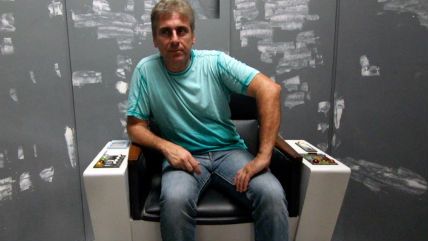Hollywood Takes on Fan Fiction
A Star Trek lover's new film is making the studios unhappy.

Since its launch in 1966, Star Trek has inspired creativity among its fans. Besides the soon-to-be six live-action television series and 13 feature films that make up the official canon, outsiders have invested time and treasure to produce myriad unofficial creations.
Early on it was mostly short stories, comic books, and art. But those outlets soon evolved into fan-made film and video productions. In 1974 a carpet layer from Michigan spent $2,000 to build a replica of the Starship Enterprise bridge and made Paragon's Paragon, one of the first serious Star Trek fan movies. In 1985, a fan convinced George Takei, who played Sulu on the original series, to reprise the role in Yorktown: A Time to Heal. In subsequent years, putting original cast members in fan productions became increasingly common, with Walter Koenig (Chekov) and Nichelle Nichols (Uhura) starring in the feature-length Star Trek: Of Gods and Men in 2007.
For decades these efforts were largely welcome. "It is now a source of great joy for me to see [fans'] view of Star Trek," wrote creator Gene Roddenberry in the foreword to Star Trek: The New Voyages, a compilation of fan-written stories. "I want to thank these writers, congratulate them on their efforts, and wish them good fortune on these and further of their voyages into other times and dimensions." Paramount and CBS, the Star Trek rights holders, took a hands-off approach so long as the fans' products didn't portray the franchise in a negative or obscene light.
That all changed with Prelude to Axanar, a professionally shot, produced, and acted short fan film that received almost 2.5 million views on YouTube. That success allowed writer/producer Alec Peters to raise more than $1 million through crowdfunding sites Kickstarter and Indiegogo to move forward with a feature film. He snagged Richard Hatch, who played Captain Apollo in the original Battlestar Galactica, to be his antagonist, and Takei plugged the project on social media.
Suddenly, Axanar looked less like fan fiction and more like competition. CBS and Paramount sprung into action, alleging copyright infringement and demanding an immediate stop to production.
Peters and his team claim that Axanar is covered by the fair use doctrine, which allows for incorporation of copyrighted work when that use is "transformative." But lawyer Dean Cheley—whose firm has made fair use claims against such powerful forces as Disney and Yoko Ono—says it's "unlikely" that fan films like Axanar fall within the doctrine's protections. Nonetheless, he adds that "while legally I believe that CBS may have a legitimate claim on its hands, I don't think it's in their best interests to pursue it. You don't want to police this sort of fanzine to such extent that you're disenfranchising your audience."
Battlestar Galactica veteran Hatch agrees. "Fan films can bring us stories that the studios aren't interested in doing, explore characters that the studios don't put a lot of energy on, and in a sense flesh out the world and build even more interest," he says. "So that when the movies from the studios come out, it actually generates more money, more fan interest, and the fan community is enlarged as a result of these really quality fan films."
With the lawsuit pending, production on Axanar has ground to a halt for now. But Peters and his team think technology and history are on their side. After all, in the wise words of Spock, "Change is the essential process of all existence."
This article originally appeared in print under the headline "Hollywood Takes on Fan Fiction."


Show Comments (318)